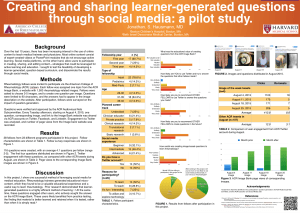
we explore the power of sharing learner-generated questions about autoinflammatory diseases through social media platforms. By harnessing the collective curiosity and engagement of learners, we can foster a dynamic learning community and promote knowledge exchange in the field.
-
Engaging Learners: Social media provides a vibrant space for learners to connect, collaborate, and ask questions about autoinflammatory diseases. Encouraging learners to actively participate by generating their own questions helps foster a sense of ownership and engagement with the topic.
-
Promoting Critical Thinking: When learners generate their own questions, they are prompted to think critically about the subject matter. By formulating inquiries, they are challenged to delve deeper into the complexities of autoinflammatory diseases, promoting a deeper understanding of the topic.
-
Knowledge Sharing: Social media platforms offer an accessible and inclusive environment for learners to share their questions with a wide audience. By posting questions related to autoinflammatory diseases, learners can invite discussion, solicit insights, and exchange knowledge with peers, experts, and patient communities.
-
Building a Learning Community: By encouraging learners to share their questions on social media, we can cultivate a supportive and collaborative learning community. Learners can connect with others who share their curiosity and passion for understanding autoinflammatory diseases, fostering a sense of camaraderie and motivation.
-
Accessing Diverse Perspectives: Social media enables learners to tap into a vast network of individuals, including healthcare professionals, researchers, and patients, who can offer diverse perspectives on autoinflammatory diseases. Learners can benefit from the insights and experiences shared by these individuals, gaining a broader understanding of the topic.
-
Promoting Empathy and Patient-Centered Learning: Autoinflammatory diseases impact individuals and their families on a personal level. By sharing learner-generated questions on social media, we can create opportunities for empathetic discussions that prioritize the patient’s perspective. This helps learners develop a holistic understanding of the challenges faced by individuals living with these conditions.
-
Crowdsourcing Solutions: Learner-generated questions can also serve as a platform for problem-solving and innovation. By posting questions related to specific challenges or gaps in knowledge about autoinflammatory diseases, learners can crowdsource solutions, brainstorm ideas, and collaborate on finding answers.
-
Leveraging Multimedia Resources: Social media platforms support the integration of various multimedia resources, such as images, videos, and infographics. Learners can enhance their questions by incorporating visual elements, making them more engaging and facilitating better comprehension and knowledge retention.
-
Encouraging Lifelong Learning: Sharing learner-generated questions through social media promotes a culture of lifelong learning. By continuously exploring new questions, seeking answers, and engaging in discussions, learners can stay updated on the latest research, advancements, and insights in the field of autoinflammatory diseases.
-
Conclusion: By leveraging the power of social media, we can create an inclusive and collaborative learning environment where learners can generate and share their questions about autoinflammatory diseases. This approach not only promotes active engagement but also facilitates knowledge exchange, critical thinking, and empathy. Let’s encourage learners to ask questions, share insights, and contribute to the collective understanding of autoinflammatory diseases through social media platforms.






